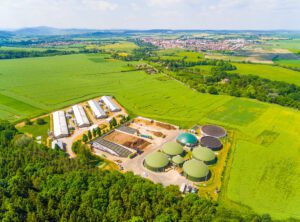Many organizations today face the challenge of turning commitment to net-zero carbon ambitions into action. The right plan can make it possible for any organization and building. Let’s explore three main steps that Schneider Electric has developed and used successfully with our facilities and for many of our customers.

Committing to net zero is an important guidepost
I take great pride in working for a company like Schneider Electric that has committed to becoming carbon neutral in our operations by 2025 and net-zero carbon across our entire value chain by 2050. These targets are our net-zero guidepost and are validated by the Science Based Targets initiative (SBTi).
In line with our ambition to contribute to limiting global temperature rise to 1.5 °C, we have already started to tackle the reduction of all three scopes of emissions, including:
- Scope 1 direct emissions resulting from the energy we consume in our buildings and processes, including fuel for fleet/corporate vehicles
- Scope 2 indirect emissions from the energy we purchase, including employee commuting and corporate travel
- Scope 3 indirect emissions from our suppliers (including supplier transportation) and more
As an impact company, we are taking a holistic view of decarbonization, bringing our entire ecosystem along, and helping our customers follow the same path. Beyond designing and constructing new net-zero-ready buildings, we know that 50% of today’s existing buildings will still be used in 2050. Therefore, we must address the decarbonization of existing buildings’ operations to make today’s biggest impact.
That’s why our plans for end-to-end decarbonization have begun with retrofitting our own office buildings and plants with digital technology to ensure success. Our vision is to create Buildings of the Future that are all-digital and all-electric to achieve net-zero goals. Your organization can do the same and use today’s technology to decarbonize. We realize that embarking on your net-zero journey can be a complex task. Our extensive experience and success can help. Let’s have a look at the approach that we’ve developed.
Three proven steps to net zero
We have identified three important steps (strategize, digitize, and decarbonize) with 10 associated priorities that help bridge net-zero ambition and action. We recommend that you apply this framework to new and existing buildings.
Strategize
The first step is assessing your current situation at both the portfolio and building levels and creating a plan to deliver measurable results.
- Creating a decarbonization roadmap Includes: determining a carbon emission baseline, assessing digital technology to identify gaps and inform the roadmap, assessing technical and economic feasibility to prioritize actions, and modeling building retrofit scenarios to develop a roadmap and timeline.
We’ll help you establish a strong plan with extensive expertise on carbon offsets and renewable energy markets, setting up reporting to align with various industry frameworks (SBTi, CDP, GRESB, etc.), and addressing decarbonization across your organization with assessments, roadmaps, and signature supplier engagement programs.
Digitize
This step creates a single source of truth for your energy and resource usage to make data-driven decisions and report on progress toward your goals.
- Track embodied carbon – Includes building information modeling (BIM)
- Measure and monitor energy and carbon – Includes: centralize energy supply and utility data, gain visibility of primary energy usage, and implement cloud-based analytics.
Decarbonize
This is where most of the action takes place. You’ll reduce your carbon footprint at scale across your portfolio and strengthen your business, leveraging the insights from steps 1 and 2.
- Reduce energy and carbon – Includes: utilize building and power management systems, access space utilization data, optimize equipment performance through predictive maintenance, and leverage AI for real-time optimization
- Purchase offsite renewables – Includes: use power purchase agreements (PPAs), purchase energy attribute certificates (EACs)
- Electrify transport – Includes: converting fleet vehicles to electric, installing EV charging stations, managing EV charging loads
- Upgrade building electrical infrastructure – Includes: optimize electrical designs, modernize electrical distribution
- Install on-site renewables – Includes: install renewable energy, store distributed energy on-site, manage loads dynamically
- Limit embodied carbon – Includes: purchase low or no-carbon products, conduct circularity assessment, extend equipment life through better lifecycle maintenance
- Offset residual carbon emissions – Includes: purchase of carbon offsets
Step-by-step to real results
Does the three-step approach work? Yes, it does. Let’s start by sharing an example of achieving net-zero carbon operations by retrofitting our Technopole building in Grenoble, France.
During our initial strategy step, we planned to redesign the existing facility to create a high-performance building that integrated a variety of uses. The building needed to ensure comfort while reducing energy consumption, achieving net-zero carbon, and reducing energy costs. Finally, the investment required a quick return on investment.
During the next step, we digitized the existing infrastructure using our EcoStruxure Building suite of building management monitoring and analytics software. The detailed data helped our facility team reveal energy inefficiencies and prioritize, track, and report maintenance issues contributing to carbon emissions. The team installed a renewable energy microgrid to enable decarbonization further using our EcoStruxure Microgrid solutions.
The results of the Technopole retrofit have been substantial:
- The site consumes only 43 kWh per sqm annually and saves 92,000 euros annually in energy costs.
- The facility has achieved net-zero carbon operation.
- It is one of the first buildings in France to achieve a LEED Platinum certificate.
- The project is delivering an ROI in 4.3 years on renovation costs.
With the repeated success of our comprehensive 3-step approach and our leading decarbonization solutions, Schneider Electric is a trusted advisor and partner for supporting your sustainability and asset performance goals over the entire lifecycle of your buildings. My next posts present customer examples that showcase how our proven step-by-step approach is helping organizations like yours to design, build, operate, and maintain net-zero buildings. We will begin by describing our work with CityCon, helping the Lippulaiva shopping center in Finland become Europe’s most environmentally responsible urban hub.



